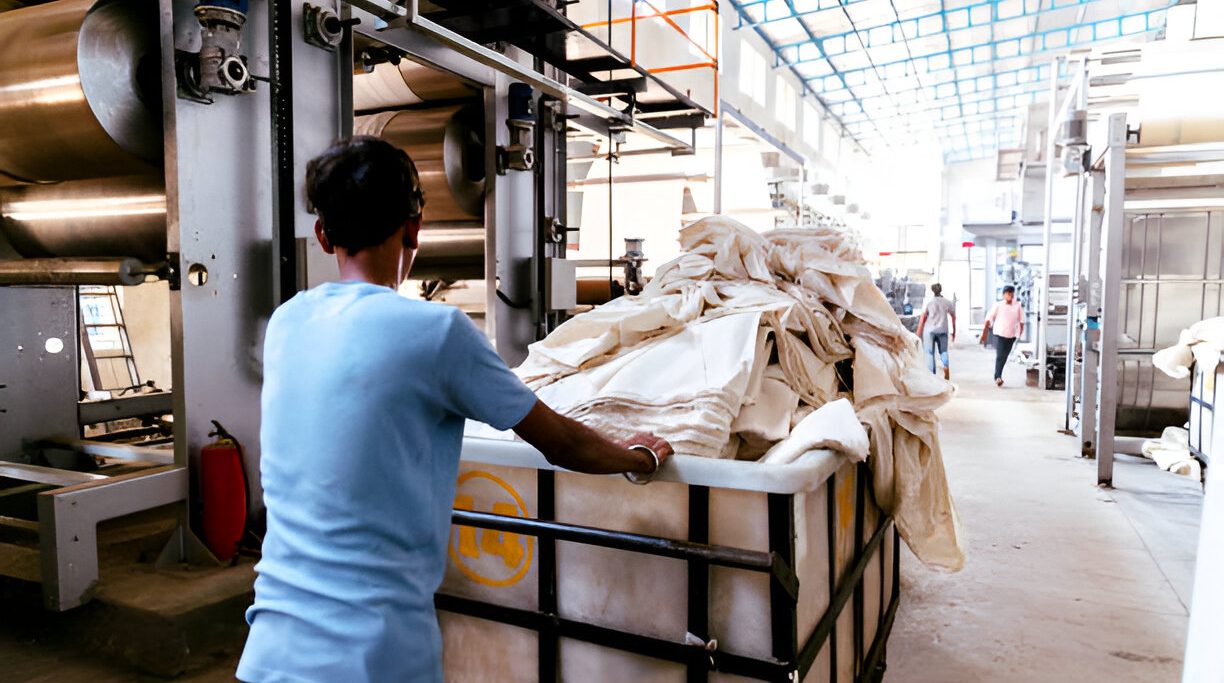Spandex, a name derived from the word “expands,” is one of the most versatile and unique fabrics in the textile industry. Known for its exceptional elasticity, it is commonly used in a variety of clothing items, particularly those that require stretch and flexibility. Whether in sportswear, swimwear, or everyday apparel, Spandex plays a critical role in offering comfort, freedom of movement, and durability. This blog will delve into what Spandex is, its history, characteristics, uses, and why it has become such an essential fabric in modern fashion.
1. The Origin of Spandex
Spandex, also known as Lycra or elastane, is a synthetic fiber that was first developed in the late 1950s by Joseph Shivers, a scientist at DuPont. The creation of Spandex revolutionized the textile industry by offering an alternative to rubber, which was the primary elastic material at the time. Rubber had its drawbacks—it was heavy, degraded easily, and didn’t offer the same level of comfort as modern stretch fabrics.
By 1962, Spandex was commercially available, and it rapidly grew in popularity due to its strength, lightweight nature, and superior stretchability. DuPont, which initially marketed Spandex under the trade name Lycra, became synonymous with the fiber, and even today, Lycra is used interchangeably with Spandex, though the latter is the generic name.
2. What Makes Spandex Special?
Spandex is known for its exceptional elasticity. It can stretch up to five to eight times its original size and return to its original shape without losing its integrity. This quality is what makes Spandex indispensable in clothing that requires stretch, such as leggings, tights, sports bras, and swimwear.
Some of the key properties that make Spandex unique are:
– Elasticity: Its stretchability is its most famous property. Spandex provides both comfort and a snug fit, making it ideal for tight-fitting garments.
– Lightweight: Spandex is lightweight, meaning it doesn’t add bulk to garments even when blended with heavier fabrics.
– Durability: Despite its stretchiness, Spandex is strong and resilient. It is resistant to body oils, sweat, and lotions, making it highly durable and long-lasting.
– Moisture-Wicking: While not inherently breathable, Spandex is often combined with other materials to create fabrics that wick moisture away from the skin, keeping the wearer dry and comfortable.
– Smoothness and Softness: Spandex is smooth to the touch and feels comfortable against the skin. This makes it suitable for clothing that needs to be worn directly on the body for extended periods.
3. How Spandex is Made
Spandex is made from polyurethane, a polymer known for its flexibility and strength. The production process is complex and involves several steps:
1. Polymerization: The process begins by creating a prepolymer, which is made by reacting a diisocyanate with a macroglycol. This reaction produces a liquid that can then be further processed to form the stretchy fibers.
2. Spinning: The prepolymer is then drawn out into fibers through a process known as extrusion. During extrusion, the liquid polymer is forced through a spinneret, forming solid fibers that are then stretched to several times their original length. This stretching gives Spandex its characteristic elasticity.
3. Finishing: After the fibers are stretched, they are treated with a finishing solution that makes them ready to be woven or knitted into fabric.
4. Blending: Most Spandex fabrics are not 100% Spandex. Instead, the fiber is blended with other materials, such as cotton, nylon, polyester, or wool, to enhance the properties of the resulting fabric. Blending Spandex with other fibers adds strength, comfort, and breathability while retaining Spandex’s signature stretch.
4. Common Blends of Spandex
Spandex is rarely used on its own. Instead, it is usually blended with other fabrics to create clothing that combines the best properties of each material. Here are some of the most common blends:
– Cotton-Spandex: This blend combines the breathability and softness of cotton with the stretch and flexibility of Spandex. It’s commonly used in casual wear, such as t-shirts, jeans, and undergarments.
– Polyester-Spandex: Polyester is a durable, quick-drying fabric, and when blended with Spandex, it creates fabrics that are ideal for activewear. The moisture-wicking properties of polyester, combined with the stretchiness of Spandex, make this blend perfect for athletic clothing like leggings, yoga pants, and sports bras.
– Nylon-Spandex: This blend is particularly common in swimwear and activewear. Nylon is smooth and resilient, and when paired with Spandex, it creates garments that are durable, flexible, and resistant to water and sweat. Nylon-Spandex blends are also used in hosiery and lingerie.
– Wool-Spandex: By blending Spandex with wool, you get a fabric that retains the warmth and softness of wool while offering the elasticity and shape retention of Spandex. This blend is used in garments that require a close fit, such as suits, jackets, and knitwear.
5. Uses of Spandex
Spandex is used in a wide range of industries and applications. Its unique properties make it the go-to material for clothing that needs to stretch, move, and retain its shape. Here are some of the most common uses of Spandex:
a. Sportswear and Activewear
One of the most significant uses of Spandex is in sportswear. Its ability to stretch without losing shape, combined with moisture-wicking properties, makes it ideal for clothing that needs to withstand intense physical activity. Yoga pants, cycling shorts, and compression garments all benefit from the flexibility and comfort that Spandex provides.
b. Swimwear
Swimwear often contains Spandex because of its resistance to chlorine and its quick-drying properties. Spandex allows swimsuits to retain their shape even after exposure to water, ensuring a snug and comfortable fit during swimming.
c. Compression Garments
In the medical field, Spandex is used in compression garments, such as socks, stockings, and bandages. These garments help improve circulation and are often prescribed to people with circulatory problems or those recovering from surgery.
d. Fashion and Everyday Apparel
Spandex is also widely used in everyday fashion, particularly in form-fitting garments like skinny jeans, bodycon dresses, and leggings. The addition of Spandex allows these garments to hug the body without feeling too tight, offering both comfort and a sleek appearance.
e. Dance and Performance Wear
For dancers and performers, Spandex is indispensable. Leotards, tights, and performance costumes often contain Spandex because it provides the necessary stretch for movement while maintaining a fitted appearance. Spandex’s ability to return to its original shape after stretching ensures that the garments look good, even after intense performances.
6. Advantages of Spandex
Spandex offers several advantages over traditional elastic materials and other fibers:
– Shape Retention: Spandex can stretch repeatedly without losing its original shape, ensuring that garments stay form-fitting over time.
– Resilience: Unlike rubber, Spandex is resistant to body oils, lotions, sweat, and detergents, making it a durable fabric choice.
– Versatility: It can be blended with various other fibers to enhance the properties of the resulting fabric, such as adding stretch to cotton or moisture-wicking to polyester.
– Comfort: Spandex is smooth, soft, and lightweight, making it comfortable for all-day wear.
– Low Maintenance: Clothes made with Spandex are often easy to care for and maintain their appearance after washing.
7. Disadvantages of Spandex
While Spandex has many benefits, it also has some drawbacks:
– Heat Sensitivity: Spandex is sensitive to heat and can lose its elasticity if exposed to high temperatures. It’s best to avoid high-heat washing or drying for garments containing Spandex.
– Not Biodegradable: Spandex is a synthetic material and does not decompose easily, contributing to environmental concerns related to plastic waste. Some brands are working on more eco-friendly alternatives or processes for Spandex production.
8. Caring for Spandex Garments
Proper care of Spandex garments ensures they maintain their elasticity and longevity. Here are some tips for keeping Spandex clothes in good condition:
– Avoid High Heat: Wash Spandex garments in cold or lukewarm water, and avoid tumble-drying on high heat.
– Gentle Detergents: Use mild detergents to prevent damage to the fibers.
– Air Dry: Whenever possible, air-dry Spandex garments to avoid the heat of the dryer.
– Avoid Bleach: Bleach can break down Spandex fibers, so avoid using it when washing these garments.
Conclusion
Spandex is a revolutionary fabric that has reshaped the textile industry with its exceptional elasticity, durability, and versatility. From sportswear to swimwear, medical garments to everyday fashion, Spandex plays a crucial role in providing comfort and flexibility to garments that need to move with the body. Understanding what Spandex is and how to care for it will help you make informed decisions about your clothing choices, ensuring that your garments look great and last for years.



